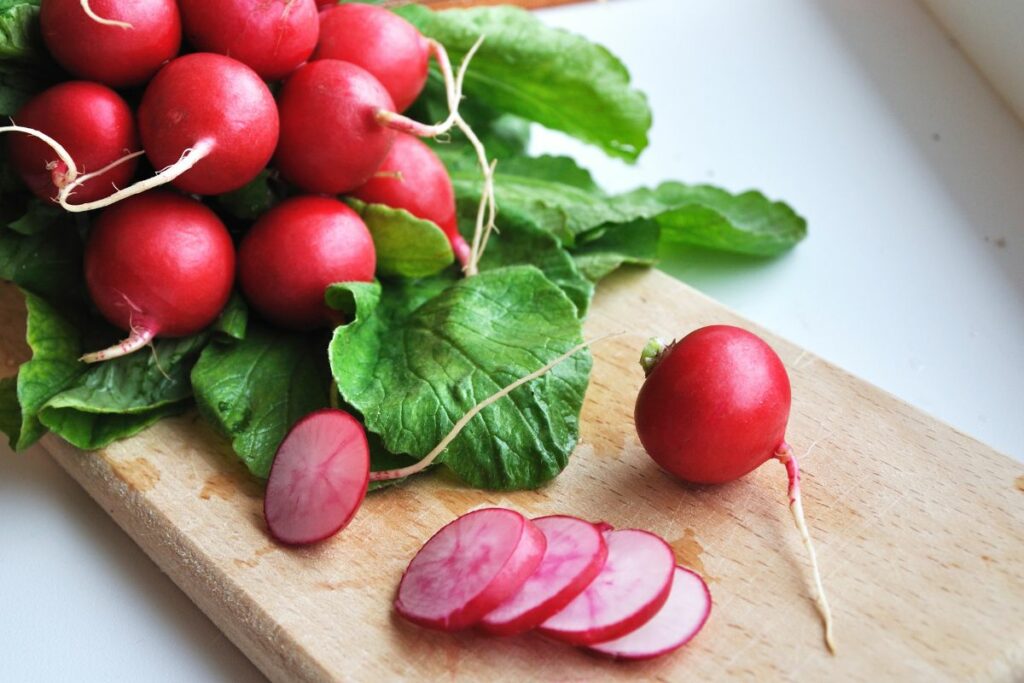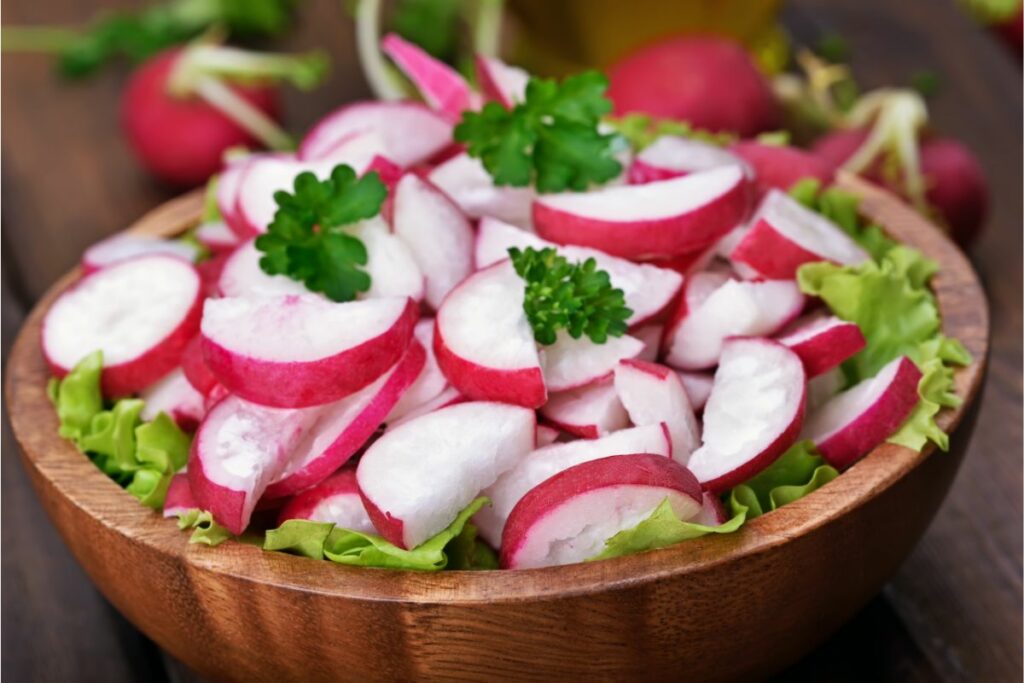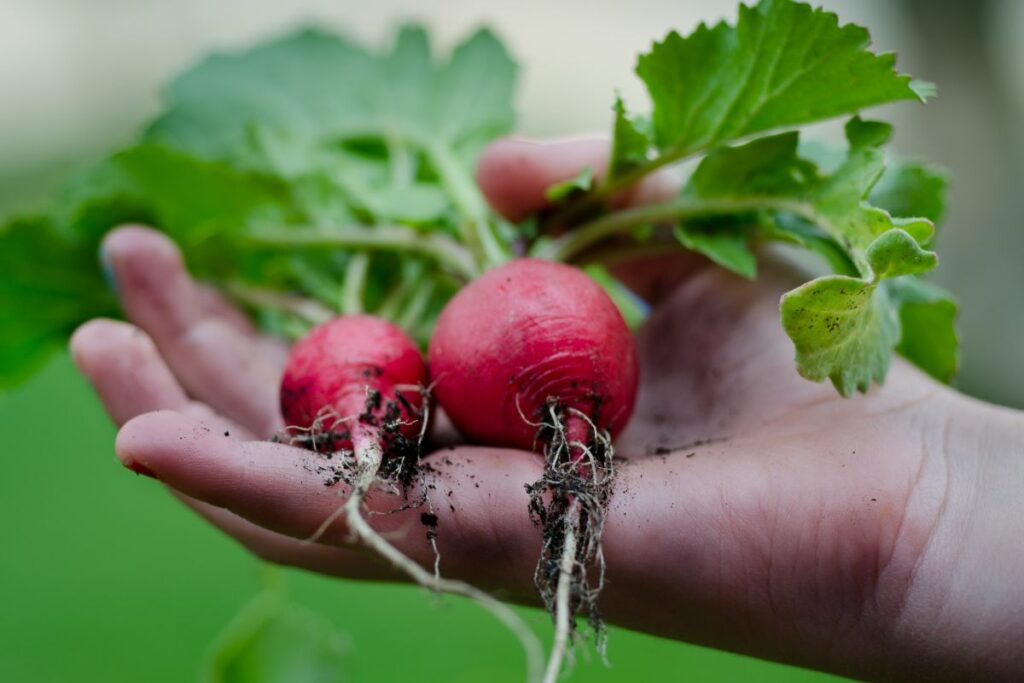Found all over the globe, radishes are available in several different sizes and shapes. You may come across traditional red ones with noticeable green tops, to larger, white-colored daikon radishes.
Radishes are often added to salads, but they can also be used to make kimchi or roasted to enjoy on the side of main meals.

If you’ve never tried a radish before, you may wonder how they taste.
Generally speaking, raw radishes taste a little different from cooked radishes. Both versions have a sharp flavor, but raw ones taste more peppery, while cooked ones taste slightly sweet.
However, different types of radishes can have different flavors, depending on the one that you use.
We’ll cover more about radishes in this post, including what they are, how you can use them, and how different radish varieties taste.
More About Radishes
Radishes are types of root vegetables that can be tapered, spherical, or oblong in shape. Similarly to broccoli and kale, radishes are cruciferous and part of the brassica vegetable class.
Radishes are available in lots of different types, all of which have a common peppery flavor. They grow easily, repel garden pests, and can be ready for harvest in as little as a month.
Radishes grow all over the globe, so they are found in many worldly cuisines. They are affordable and don’t need much preparation as they are edible when raw.
Ways Of Using Radishes
Traditional red radishes are regularly enjoyed raw. You can serve seasoned, thin slices of them as a healthy snack, or enjoy them on a platter with creamy dips.
Though radishes taste nice on their own, you can use some salt and butter to enhance their flavors.
As they are crunchy, radishes are also nice to ferment and enjoy pickled. Roasted radishes also soften and lose some of their sharp notes, taking on a slightly sweeter taste.
Watermelon radishes and black radishes work well as garnish on top of dishes. Black radishes are tasty when roasted, as this drastically tones down their peppery notes.
If you have tried horseradish in a jar before, consider giving the real thing a go. Fresh horseradish is crisp and robust, but it doesn’t have the bitter nature associated with jar versions.
Fresh horseradish can liven up dishes, particularly stews and hearty roasts around wintertime.
How Do Radishes Taste?

Now that you know a bit more about radishes, we can cover what they taste like.
Raw Radishes
In most cases, raw radishes taste a little like black pepper. They have a spiciness that resembles raw garlic and a crisp, crunchy consistency.
Radishes have a potent smell, in the same way garlic and onions do. However, instead of a pungent odor, radishes smell more like black pepper.
If you’ve never eaten raw radishes before, keep this in mind, as their strong flavors and smell may be too much for you.
Cooked Radishes
Cooked radishes taste slightly different from their raw form. Though raw radishes work well in salads, their strong spicy notes may be too much for some people. If this is the case, you can cook or boil radishes to tone down their flavor.
Cooking makes the radishes lose their potent peppery taste, as well as their crunchy texture. Once you’ve cooked or boiled them overheat, the radishes take on a sweeter taste with a softer feel.
Different Radish Varieties
Radishes can also taste different depending on their type. Each variety has its own interesting look and flavor.
There are lots of different radishes to choose from, but we’ll cover the taste of some more common examples below.
Black Radishes
As the name implies, black radishes have a darker exterior, though their insides are white. These generally aren’t as large as normal radishes, but they have a particularly sharp taste.
Black radishes are ideal for spice lovers, but if you aren’t used to strong flavors, you may want to opt for a different type, or cook them to tone down their notes.
Watermelon Radishes
Watermelon radishes have a soft inner component that contains a lot of water, in the same way that watermelon does, which explains the radishes’ name.
They have purple and red flesh with green skin on the outside, along with a distinct peppery flavor.
Easter Egg Radishes
Easter egg radishes are very colorful, ranging from pink and purple to white and red. They have a crunchy consistency and peppery flavor, though this isn’t as strong compared to other types of radishes.
Easter egg radishes aren’t a separate type of radish, but a mix of different types that give the vegetables their colorful appearance.
Early Scarlet Globe Radishes
This is a popular type of radish that’s planted in home gardens all over the globe. These radishes are bright red, small, and spherical, with a lighter taste.
You can find them growing all over the world as they have an ideal temperature tolerance. This protects the radishes to keep them safe in severe conditions.
Daikon Radishes
Daikon radishes are lengthy, white, and tapered in shape. They are more popular in Asian countries and work well in certain dishes, like salads and miso broth recipes.
Daikon radishes roughly resemble big carrots. They have a crisp consistency and gentle taste, which may make them a better choice for those that aren’t spice fans.
White Radish
These radishes have light yellow skin, though they can start to brown before they lose their firm consistency.
These radishes are thin, lengthy, and have a gentle peppery flavor. They grow easily at a fast rate, which explains why it’s one of the more common radish types.
Horseradish
Horseradish is very spicy, sharp, and pungent. They have white flesh, lighter brown skin, and a long, rounded shape. It’s generally used as a spicy dressing to flavor different dishes.
Health Benefits Of Radishes

Radishes have lots of health benefits with similar nutritional characteristics across different kinds of radishes.
Antifungal
Radishes notably contain RsAFP2, an antifungal protein that is known to make Candida albicans cells die.
Candida albicans is a fungus that causes yeast infections, but this antifungal protein may prevent the fungus from accumulating within your system.
Diuretic
Radishes also have diuretic purposes, so they can keep your urinary tract and kidneys healthy and clean.
In a similar way to several cruciferous vegetables, they are high in dietary fiber and water. This is ideal for maintaining a healthy digestive system.
Glycemic Index And Blood Sugar
The GI (glycemic index) is an overall measure of how carbohydrates influence blood sugar levels. Radishes are lower on the glycemic index, as there are just four grams of carbs in a cup of radishes.
People concerned about their blood sugar can add low-GI foods, like radishes, to their diet without them spiking blood glucose levels.
Vitamins And Minerals
Radishes also contain a lot of potassium, vitamin B6, and vitamin C. There’s roughly 20% of your daily vitamin C requirements in a single cup!
Potassium is also significant regarding blood pressure. It can relieve tension within blood vessel walls, making it easier for blood to pass through to lower blood pressure.
Fights Oxidative Stress
Research has indicated that radishes can fight oxidative stress. This occurs when there is a large quantity of harmful free radicals within your system.
Antioxidants, like the ones within radishes, can help your body fight their dangerous effects to maintain proper health.
Where To Find Radishes
You can find radishes sold in most grocery stores, though these tend to be more common types, like red radishes or daikon.
Grocery stores with a wider product range should have several radishes on offer, but if your local store is small, you can visit your nearest farmers market to check.
Radishes are some of the first vegetables that appear in spring, so farmers sell many colorful types around this time. You have more chances of finding black, watermelon, and horseradishes at farmers’ markets.
If you ever see daikon radishes on offer that still have their greens nearby, snap them up as soon as you can.
These newly harvested daikons tend to have a gentler taste, while their greens can be sprinkled into soups, stir-fried with other ingredients, or enjoyed within salads.
How To Store Radishes
Radishes keep well when kept in the refrigerator. If they are bought fresh from a farmer’s market, they may be able to last for two weeks.
To store radishes in the fridge, take off any greens, then transfer them, unwashed, into a plastic zip-tie bag with a clean paper towel.
One way of increasing your radishes’ shelf life is by turning them into pickles. You can do this by fermenting them or using them in a sauerkraut recipe.
Final Thoughts
Radishes have a distinct flavor that tastes like black pepper. However, raw radishes taste sharper compared to cooked ones, as the heat turns the radish into a soft, sweet vegetable.
Various types of radishes have different flavors too. Horseradish and black radishes taste more robust, while white ones have a gentler flavor.
Radishes can be enjoyed raw and cooked, but remember to keep them in the fridge to increase their lifespan.
We hope you enjoyed learning about radishes and consider adding them to your meals!
- How To Reheat A Cheesesteak - November 5, 2023
- What Are Three Must Have Kitchen Knives? - September 22, 2023
- How To Protect Edges Of Pie Crust - June 15, 2023








